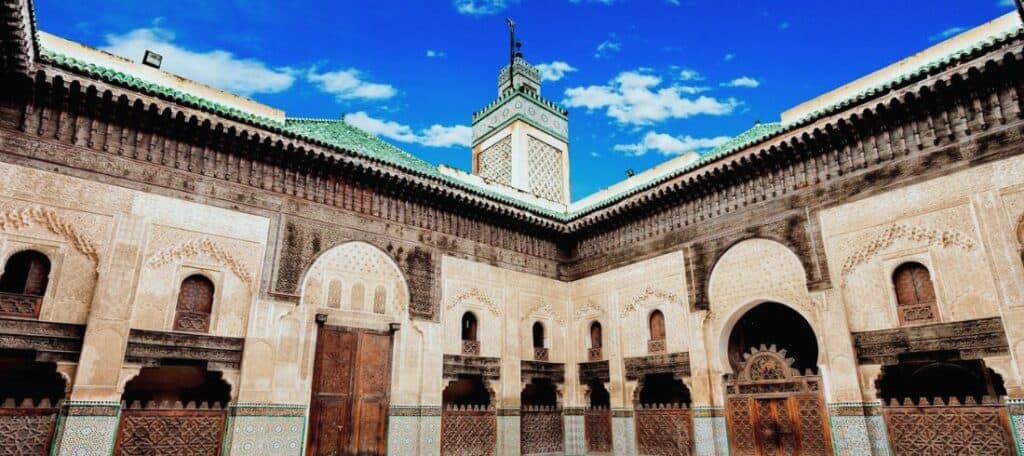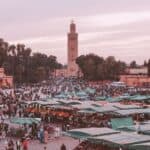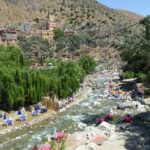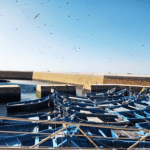
In the lively city of Fez, the Bou Inania Madrasa is a beacon of Moroccan tradition and Islamic design. It sits at coordinates 34°03′43″N 4°58′58″W. This place takes you back to 1350 CE, when its building started. It’s huge, covering 34.65 by 38.95 meters.
The stories of Sultan Mulay Sliman’s time fill the air. There’s even a hydraulic clock that used to tell time with water.
Walking in through its two gates, you step into history. This madrasa, with its marble courtyard, buzzed with learning once. It’s the only madrasa in Morocco that’s also a mosque.
Now, it’s a key source of Fez’s charm. And it ranks among the top sights in Meknes, Morocco. People everywhere rate it highly, just like other famous places.
The Architectural Grandeur of Bou Inania Madrasa
Within the lively Fez Medina, a UNESCO World Heritage Centre, Bou Inania Madrasa shines. It combines beauty with functionality, showing Islamic influence and Moorish style in Moroccan architecture. For centuries, it has been a place where young Muslim men learned about the Koran and Islamic law. Today, it attracts visitors from outside the usual tourist trails, offering a glimpse into Morocco’s educational past.
The Fusion of Functionality and Aesthetics
Bou Inania Madrasa’s design isn’t just for show. Its zellige tiles and cedar screens from the 1300s show the Marinid dynasty’s effort to blend learning with art. Each tile adds to the beauty and makes a perfect place for studying and thinking. This blend of design and function is a hallmark of their architectural tradition.
Islamic Influence and Moorish Elegance
The madrasa is a beautiful example of Islamic art and Moorish style. Its design includes amazing mosaics and cedarwood screens. The decor, rich in Moorish style, demonstrates the madrasa as a model of architecture influenced by Moorish culture. Its beauty reflects Islamic values like symmetry, appealing to Morocco’s Muslim community. Thus, it stands as a significant piece of Moroccan architecture.
The Masterpiece Courtyard: Marble, Mosaics, and Cedarwood
The heart of Bou Inania Madrasa is its stunning courtyard. This open space combines marble, mosaics, and cedarwood. It celebrates natural light and air, showcasing the Marinids’ architectural skill. The mix of materials from near and far highlights the madrasa’s diverse architectural influences, inspiring both scholars and visitors alike.
Near Fez Medina in Ain Nokbi district, local workshops keep the tradition of fine craftsmanship alive. Their work in zellige and pottery adds to the madrasa’s majestic beauty. The courtyard’s dynamic designs reflect the cultural mix that has influenced this historic place. It’s a peaceful spot that invites visitors to step back into the golden age of Islamic education.
Unveiling the Rich History Behind Bou Inania Madrasa in Fez
Rich history of Bou Inania Madrasa shows us how the past and present of Fez are closely linked. As a highlight of Moroccan architectural history, this building was made during Sultan Abu Inan Faris‘ time. It tells us about history and shows the art from long ago. In 1351, they started building the Bou Inania Madrasa. This marked the beginning of an important era for future generations.
From Sultan Abu Inan Faris to Modern Times
The significance of Bou Inania Madrasa is more than just a school. It stands for divine power and smarts, too. Built by Sultan Abu Inan Faris, it became a key building in Fez’s culture and politics. Through many years, it was carefully kept up. This shows deep respect for its past.
Understanding the Islamic Educational Legacy
The walls of Bou Inania Madrasa tell the story of madrasas in Islamic history. These schools were central to learning for many scholars. It stands as a symbol of Islamic educational legacy, playing a big role in spreading Islamic learning and thinking. This place is a prime example of an intellectual and spiritual hub.
Visitor’s Guide to Bou Inania Madrasa
Going to Bou Inania Madrasa in Fez is a must-do for anyone loving history. This place is a key part of Morocco’s past. It’s more than just a fez tourist attraction. It’s a live reminder of how grand old Islamic learning centers were. Placed in the heart of Fez’s medina, a UNESCO World Heritage Centre, it stands as a beacon of knowledge. Amidst the city’s lively chaos, it’s a peaceful spot.
This visitor’s guide to Bou Inania Madrasa gives you all the practical information for visiting Bou Inania Madrasa you need. Remember to dress modestly to respect its spiritual importance. Taking off your shoes before entering sacred areas helps protect the floors. These floors have seen many scholars throughout the years. The Madrasa also closes for prayers, respecting its religious role.
- Location: Heart of Fez’s Medina UNESCO World Heritage Centre
- Constructed: 1350-1355, a dual-function as a madrasa and mosque
- Significance: Largest Marinid madrasa in Morocco, symbol of political legacy
- Area: Irregular rectangle, 34.65 x 38.95 meters, with living quarters and mosque
- Access: Two entrances on Tala’a Kebira and Tala’a Seghira streets, two stairways to student quarters on the upper floor
- Advice: Modest dress, shoe removal in sacred areas, visit outside prayer times
The beauty of Bou Inania Madrasa goes beyond its walls. The Fez medina is full of experiences. You can visit workshops in the Ain Nokbi district, see wooden creations at the Nejjarine Museum, or join tours on Islamic architecture. There’s also the story of Kate Kvalvik and her husband, Alaa Said. They revived Dar Seffarine, mixing history with modern comfort.
Seeing Bou Inania Madrasa means connecting with Fez’s soul. It lets you travel through history. This guide aims to make your visit both insightful and magical.
Bou Inania Madrasa in Fez: An Emblem of Cultural Significance
The Bou Inania Madrasa in Fez is more than an ancient building. It shows the rich history and architecture of Morocco. It is deeply connected to the country’s culture. Serving as a strong symbol of Moroccan identity, it highlights Fez’s achievements in the middle ages.
This famous school highlights the best time of Fez’s Islamic era. Back then, Fez was known worldwide for its knowledge and spiritual depth.
A Symbol of Fez’s Islamic Golden Age
Constructed between 1350 and 1355, The Bou Inania Madrasa stands tall. It reflects Moroccan architecture and Fez as a center of knowledge during the Islamic Golden Age. Al-Qarawiyyin in Fez, started between 857 and 859, is the oldest educational place. It inspired the education system in Bou Inania Madrasa.
As one of six madrasas fixed up since 2017, Bou Inania shows Fez’s pride in its past. It’s a commitment to preserving culture.
How Bou Inania Madrasa Reflects Moroccan Identity
The Bou Inania Madrasa is known for its beautiful Moroccan design. It uses traditional tiles, cedar wood, and mixes Moorish and Islamic styles. It shows Moroccan heritage in arts and theology. The Qarawiyyin library in Fez, with 4,000 manuscripts, shows the nation’s love for learning. It includes works by Ibn Khaldoun.
Today, the madrasa is both a historic site and a modern symbol of learning. It has about 40 students from Qarawiyyin University. This place, where education, architecture, and religion meet, is still a source of pride. It shows the deep cultural roots in Bou Inania Madrasa.
Conclusion
Bou Inania Madrasa in Fez is more than an architectural wonder. It is a bridge to Morocco’s glorious past. It lets us see the deep education and culture that once flourished there. The madrasa’s beauty, from its zellige tiles to cedarwood, tells a bigger story. It highlights the Islamic Golden Age and Morocco’s respect for knowledge.
Visitors here experience a key part of history. Education and beauty come together here. They tell tales of scholarly quest and traditions that shaped Morocco’s culture.
Bou Inania Madrasa reflects the history of the Al-Qarawiyyin mosque, the world’s oldest university. It shows the importance of learning in Islamic tradition. This madrasa shows Morocco’s dedication to education through history. It watches over Fez, a city filled with history and Moroccan pride.
Thinking about Bou Inania Madrasa, we must recognize its cultural role. This Quranic school, part of Fez’s UNESCO World Heritage Site, showcases traditional skills. Its architecture, the medina’s artisans, and the history under Bab Boujloud all play a part. Bou Inania Madrasa’s identity honors its beauty, history, and the Islamic and Moroccan impact on society, education, and culture. It is a tribute to how Islamic and Moroccan values shape education and cultural expression.








